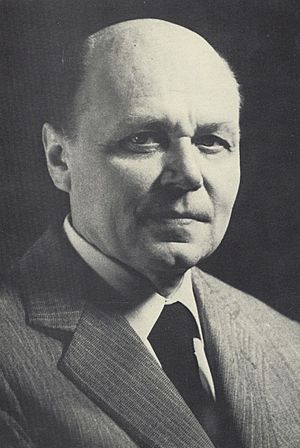Friedrich Stelzner facts for kids
Friedrich Stelzner (born November 4, 1921 – died June 5, 2020) was a German doctor who specialized in surgery. He was a scientist and a teacher, focusing on surgery of the stomach and intestines. He led three different university surgery departments and became the President of the German Society for Surgery in 1985. Stelzner wrote many books and over 450 articles and presentations. He spent his career studying how the body works and how that knowledge could improve surgery.
Contents
Early Life and Becoming a Doctor
Friedrich Stelzner was born in Františkovy Lázně, which was then part of Czechoslovakia, on November 4, 1921. He was the only son of Georg Stelzner, a railway worker, and Helene Brandner. Helene's father was a skilled craftsman from the nearby town of Cheb.
Friedrich spent his early years in Františkovy Lázně and went to high school in Cheb. He later studied medicine in several cities, including Berlin and Munich. He finished medical school in 1945 with top honors, known as Summa cum laude. Soon after, he began his training to become a surgeon at the University of Erlangen-Nuremberg. He became a certified general surgeon in 1949. Three years later, he became a university lecturer, based on his important work about removing certain types of cancer.
Working at the University of Hamburg (1955–1967)
In 1955, Stelzner joined the surgery team at the University of Hamburg. He received a special scholarship to train further in bowel surgery at St Mark's Hospital in London, United Kingdom. Working with leading surgeons there greatly influenced him. It made him want to specialize even more in this area.
Inspired by his experiences, Stelzner wrote a very important book about anorectal fistulas. These are small tunnels that can form near the bottom. For this book, he won the Langenbeck prize in 1960. This was the highest science award from the German Society for Surgery.
Stelzner also studied hemorrhoids with an anatomist named Jochen Staubesand. They found that hemorrhoids are not just swollen veins. Instead, they are special cushions of blood vessels. He called them corpus cavernosum recti. He also developed ideas about how the body controls bowel movements. He showed that this control system is different in males and females. This difference is important for how certain surgeries are done.
Further studies by Stelzner looked at the spiral shape of the muscles in the esophagus, which is the tube that carries food to the stomach. Understanding these muscles helps doctors treat problems like achalasia (difficulty swallowing) and gastroesophageal reflux disease (heartburn).
Leading Surgery Departments (1967–1987)
In 1967, Stelzner was offered the chance to lead the surgery department at the University of Tübingen. Around the same time, he was also offered the top job in Hamburg. He chose to stay in Hamburg and became a professor and chairman at the University Medical Center Hamburg-Eppendorf in 1968.
Just two years later, Stelzner moved to lead the surgical department at the Goethe University Frankfurt. Here, he worked closely with Dietrich Starck, who studied how different animals' bodies are built. Stelzner also studied the causes of problems like appendicitis (inflammation of the appendix) and diverticulitis (small pouches in the digestive tract).
In 1976, Stelzner received offers to lead surgery departments in both Vienna and Bonn. He decided to go to Bonn. During this time, he did many studies on the causes of skin conditions like pilonidal sinus disease and suppurative hidradenitis. He also studied how pelvic structures develop and work. In 1985, Stelzner became the President of the German Society for Surgery.
Later Years and Scientific Work
Stelzner announced his retirement in 1987. However, he continued to lead the university hospital for two more years until his replacement arrived in 1989. In the years that followed, Stelzner still performed some minor surgeries. After 1995, he stopped working as a clinical surgeon.
His main focus then became his scientific research. He discovered that there are two separate lymphatic systems in the body. One is just under the skin, and the other is deeper inside the body. He passed away in June 2020 at the age of 98.
Awards and Special Recognitions
- Langenbeck prize, the highest science award of the German Society for Surgery (1960)
- Honorary doctorate from the University of Seoul (1983)
- President of the German Society for Surgery (1985)
- Honorary doctorate from the University of Munich (1987)
- Member of the German Academy of Sciences Leopoldina (1987)
- Officer's Cross, Order of Merit of the Federal Republic of Germany (1993)
- Ernst Jung Gold Medal for Medicine (1997, Ernst Jung Foundation)
Images for kids



